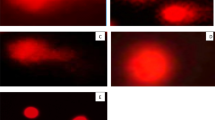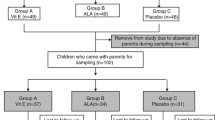Abstract
The present work investigated the activity of Cu/Zn superoxide dismutase enzyme (SOD) in red blood cells and glutathione peroxidase enzyme (GPx) in whole blood by spectrophotometric methods. Plasma levels of the cofactors copper and zinc and whole-blood selenium were evaluated using atomic absorption spectrophotometer. The study included a population of 18 Down’s syndrome (DS) patients with complete trisomy 21 (group 1), translocations (group 2), and mosaicism (group 3), and their 15 matched controls. The purpose of this work was to study the gene dosage effect of SOD and its consequence on GPx enzyme and the various cofactors, and to find out correlations with developmental fields. Our results showed that in the population with complete trisomy 21 and translocations, SOD and GPx activities were increased, whereas in cases with mosaicism, the enzymes activities were within normal limits. Plasma copper concentrations were increased, whereas whole-blood selenium concentrations were significantly decreased in the three DS groups. Plasma zinc levels were within normal in all patients. We concluded that changes in trace elements and enzyme activities were not related to age or sex. Also, there was no correlation between the enzyme levels and the developmental activities. Our results are useful tools for identifying nutritional status and guiding antioxidant intervention.
Similar content being viewed by others
References
OMIM (2000). http://www.ncbi.nlm.nih.gov/Omim.
Y. Groner, O. Elroy-Stein, K. B. Avraham, M. Schickler, H. Knobler, D. Minc-Colombo, et al., Cell damage by excess CuZnSOD and Down syndrome, Biomed. Pharm. 48, 231–240 (1994).
J. Huret, J. Delabar, F. Malhens, A. Aurias, A. Nicola, and M. Berthien, Down syndrome with duplication of a region of chromosome 21 containing Cu/Zn superoxide dismutase gene without detectable karyotypic abnormality, Hum. Genet. 75, 251–257 (1987).
M. S. Z. Salem and A. M. A. Hammouda, Lipid peroxidation in Down’s syndrome, Practitioner East Medit. Ed. 9(12), 453–456 (1998).
K. Bagchi and S. Puri, Free radicals and antioxidants in health and disease, East. Medit. Health J. 4(2), 350–360 (1998).
M. C. Pastor, C. Sierra, M. Dolade, E. Navarro, N. Brandi, E. Cabre, et al., Antioxidant enzymes and fatty acid status in erythrocytes of Down’s syndrome patients, Clin. Chem. 44(5), 924–929 (1998).
G. Gerli, L. Zenoni, G. F. Locatelli, R. Mongiat, F. Piattoni, G. B. Orsini, et al., Erythrocyte antioxidant system in Down syndrome, Am. Med. Genet. 7(Suppl.), 272–273 (1990).
I. E. Mine, O. Portakal, and F. Ozdemir, Erythrocyte glutathione system and children with Down syndrome, Dev. Med. Child. Neurol. 41(2), 141–142 (1999).
D. E. Paglia and W. N. Valentine, Studies on the quantitative and qualitative characterization of erythrocyte glutathione peroxidase, J. Lab. Clin. Med. 70(1), 158–169 (1967).
J. B. de Haan, F. Cristiano, R. C. Iannello, C. Bladier, M. J. Keiner, and I. Kola, Elevation in the ratio of Cu/Zn-superoxide dismutase to glutathione peroxidase activity induces features of cellular senescence and this effect is mediated by hydrogen peroxide, Hum. Mol. Genet. 5(2), 283–292 (1996).
G. Anneren and M. Gebre-Medhin, Trace elements and transport proteins in serum of children with Down syndrome and of healthy siblings living in the same environment, Hum. Nutr. Clin. Nutr. 41(4), 291–299 (1987).
F. Teksen, B. S. Sayli, A. Aydin, A. Sayal, and A. Isimer, Antioxidative metabolism in Down syndrome, Biol. Trace Element Res. 63(2), 123–127 (1998).
J. Kadrabova, A. Madaric, M. Sustrova, and E. Ginter, Changed serum trace element profile in Down’s syndrome, Biol. Trace Element Res. 54(3), 201–206 (1996).
F. Licastro, E. Mocchegiani, M. Masi, and N. Fabris, Modulation of neuroendocrine system and immune functions by zinc supplementation in children with Down’s syndrome, J. Trace Elements Electrolytes Health Dis. 7(4), 237–239 (1993).
I. Bucci, G. Napolitano, C. Giuliani, S. Lio, A. Minnucci, F. Di Giacomo, et al., Zinc sulfate supplementation improves thyroid function in hypozincemic Down children, Biol. Trace Element Res. 67(3), 257–268 (1999).
A. Madaric, E. Ginter, and J. Kadrabova, Serum copper, zinc and copper/zinc ratio in males: influence of aging, Physiol. Res. 43(2), 107–111 (1994).
G. Anneren, M. Gebre-Medhin, and K. H. Gustavson, Increased plasma and erythrocyte selenium concentrations but decreased erythrocyte glutathione peroxidase activity after selenium supplementation in children with Down syndrome, Acta Paediatr. Scand. 78, 879–884 (1989).
M. E. Percy, A. J. Dalton, V. D. Markovic, D. R. McLachlan, J. T. Hummel, A. C. Rusk, et al., Red cell superoxide dismutase, glutathione peroxidase and catalase in Down syndrome patients with and without manifestations of Alzheimer disease, Am. J. Med. Genet. 35(4), 459–467 (1990).
R. De La Torre, A. Casado, E. Lopez-Fernandez, D. Carrascosa, V. Ramirez, and J. Saez, Overexpression of copper-zinc superoxide dismutase in trisomy 21, Experientia 52, 871–873 (1996).
J. B. de Haan, F. Cristiano, R. C. Iannello, and I. Kola, Cu/Zn-superoxide dismutase and glutathione peroxidase during aging, Biochem. Mol. Biol. Int. 35(6), 1281–1297 (1995).
P. M. Sinet, J. Lejeune, and H. Jerome, Trisomy 21 (Down’s syndrome), gluathione peroxidase, hexose monophosphate shunt and IQ. Life Sci. 42(1), 29–34 (1979).
K. Brugge, S. Nichols, T. Saitoh, and D. Trauner, Correlations of glutathione peroxidase activity with memory impairment in adults with Down syndrome, Biol. Psychiatry 46(12), 1682–1689 (1999).
L. A. Smolin and M. B. Grosvenor, Trace minerals: our elemental needs. in Nutrition: Science and Applications, 2nd ed., WB Saunders, Philadelphia, pp. 318–350 (1997).
Author information
Authors and Affiliations
Rights and permissions
About this article
Cite this article
Meguid, N.A., Kholoussi, N.M. & Afifi, H.H. Evaluation of superoxide dismutase and glutathione peroxidase enzymes and their cofactors in egyptian children with down’s syndrome. Biol Trace Elem Res 81, 21–28 (2001). https://doi.org/10.1385/BTER:81:1:21
Received:
Revised:
Accepted:
Issue Date:
DOI: https://doi.org/10.1385/BTER:81:1:21




